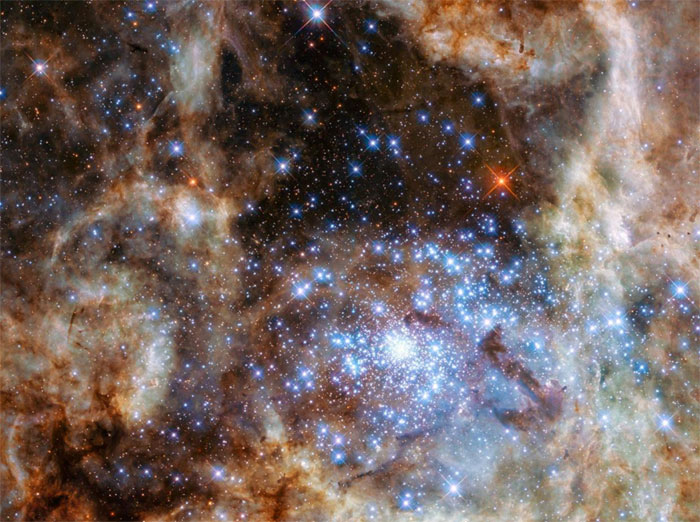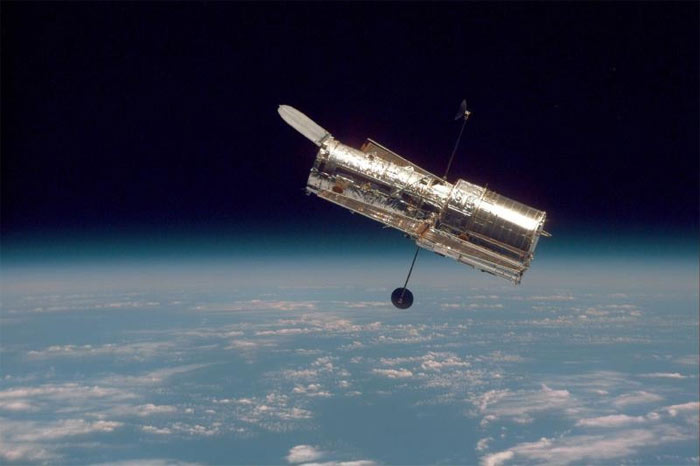Detecting star clusters 30 million times brighter than the Sun.
Scientists have found the largest star cluster in the universe to date, with a brightness of 30 million times the Sun.
In the vast universe there are many stars that are capable of surpassing our Sun's brightness. People have found brighter stars than the Sun thousands, tens of thousands, millions, even tens of millions of times.
And recently, astronomers have found a cluster of stars (cluster) with extremely terrible brightness: 30 million times the Sun - named R136 .

Specifically, with the Hubble Space Telescope , scientists at the University of Sheffield (UK) have found a cluster of 9 giant stars located 170,000 light-years from Earth. This is also the largest star cluster ever identified in this universe.
The R136 only spans a few light years, belonging to a Milky Way galaxy . But in that " cramped " space , the stars are big, glowing with a huge amount of ultraviolet rays.
However, these new stars, when standing alone, cannot match the R126a1 - the heaviest " star " in the universe to date, with 250 times the mass of the Sun.
The R136 was actually published in 2010 by Professor Paul Crowther from DH Sheffield, with four stars weighing 150 times the Sun. So far, they have found 5 more stars, bringing the total number of stars in this cluster to 9.

Hubble Space Telescope
The new discovery has led experts to question the formation of super-heavy stars . According to Professor Saida Caballero-Nievees: "The previous hypothesis is that these monster stars were born due to the combination of low-mass stars in the same binary system. But with what we are seeing "This is clearly not the right reason for all R136 members. Most of them are monsters right from the beginning."
In addition, the R136 has once again demonstrated the power of the Hubble Telescope - the device is said to be " old " and about to be replaced in the future.
The study was published in the Royal Astronomical Society of the British Society.
- The star is brighter than the Sun.
- The star is 20 million times brighter than the sun
- Discovering 'green spots' in the universe
- Photo of the universe: The star is 150 times brighter than the Sun.
- Detect extremely bright stars in the sky
- The moment the two star clusters become one
- The supernova is 20 times brighter than the Milky Way
- The formation of the star is 300 times brighter than the Sun.
- The star is 10,000 times brighter than the Sun can prevent life from evolving
- 4 galaxy clusters collide 3 billion light-years from Earth
- The galaxy cluster has three million billion times the mass of the Sun.
- The painful death of a star ripped apart by a supermassive black hole
 Van Allen's belt and evidence that the Apollo 11 mission to the Moon was myth
Van Allen's belt and evidence that the Apollo 11 mission to the Moon was myth The levels of civilization in the universe (Kardashev scale)
The levels of civilization in the universe (Kardashev scale) Today Mars, the sun and the Earth are aligned
Today Mars, the sun and the Earth are aligned The Amazon owner announced a secret plan to build a space base for thousands of people
The Amazon owner announced a secret plan to build a space base for thousands of people NASA discovers two stars colliding so violently that they created gold
NASA discovers two stars colliding so violently that they created gold  James Webb Telescope Discovers Massive Supercluster Hidden Deep in the Milky Way
James Webb Telescope Discovers Massive Supercluster Hidden Deep in the Milky Way  'Time travel' 13.5 billion years, NASA telescope finds 4 cosmic ancestors
'Time travel' 13.5 billion years, NASA telescope finds 4 cosmic ancestors  Why there are no stars in American photos of the Moon
Why there are no stars in American photos of the Moon  Aliens control the fastest moving stars in the galaxy?
Aliens control the fastest moving stars in the galaxy?  First 'hybrid' star and planet object revealed outside the Milky Way
First 'hybrid' star and planet object revealed outside the Milky Way 